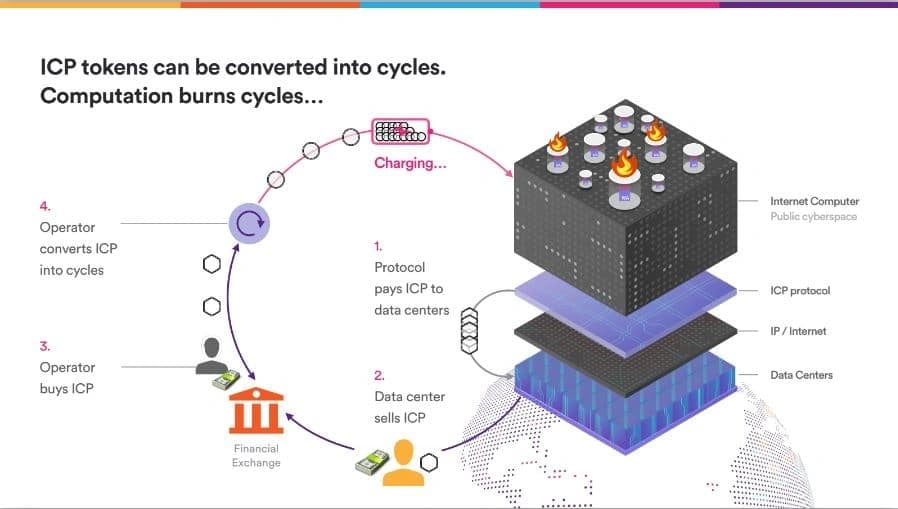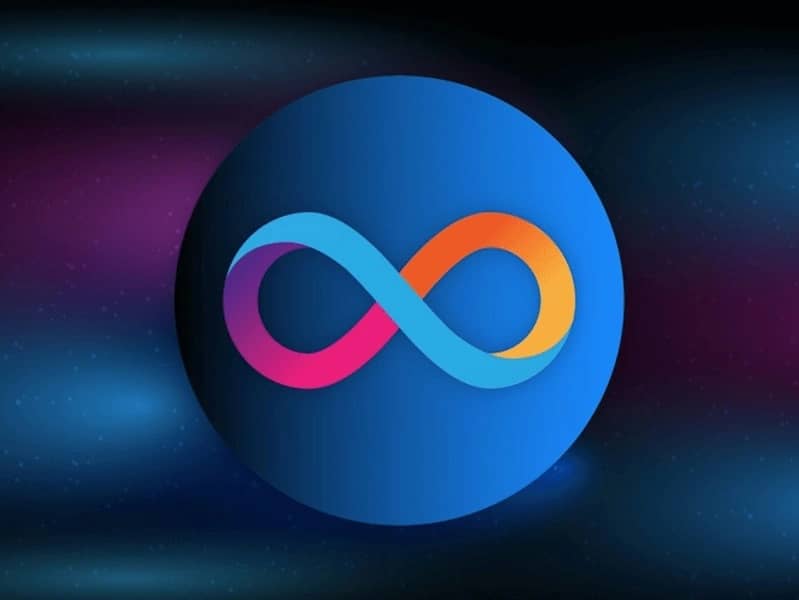订阅 wiki
Share wiki
Bookmark
Internet Computer ICP
Internet Computer ICP
Internet Computer is a blockchain network that allows the creation of web-based services on a secure and decentralized protocol. [3] The Internet Computer is powered by the Internet Computer Protocol (ICP) token formerly known as DFN, which enables users to re-create the web and power apps in a more propagated form, pay fees for transactions on the blockchain (serves as a gas for transactions), reward participants or data centers and make governance decisions where holders can vote on the future of the network. The ICP token is a utility token that plays a key role in the Internet Computer network.[8] [9] testing
History
In early 2016, Internet Computer came as an idea conceived by Dominic Williams, the chief scientist and founder of DFINITY. DFINITY is a not-for-profit digital foundation that developed and maintained the Internet Computer project for 5 years before its official launch. [5] [6] Until 2018, funding rounds were conducted for Dfinity which raised about $121 million from contributors namely Andreessen Horowitz, Polychain Capital, Aspect Ventures [16], including an initial coin offering (ICO) in 2017 before the network token was distributed. The tokens worth about $35 million were released via an airdrop [13] in 2018.[1]
By 2019, the full development of the token started with the release of Copper and the ICP went live in May 2021. It enabled the reach for blockchain singularity. That is a blockchain that is able to run the web from hostage to storage and services, having everything in a secure protocol without the interference of a third party. Ethereum alike, ICP allows the launch of decentralized applications (DApps) in its network but makes use of the upgraded version of smart contracts (as present in blockchains like Ethereum) in the ICP network called Canisters. [14]
According to the founder, the Internet Computer Protocol (ICP) token symbolizes the third major innovation in blockchain technology after Bitcoin and Ethereum. This innovation is perceived as one evolving the internet into its next big event.
"Internet Computer has come to put an end to big tech monopolies and replace the overly circulated cloud service system with a more decentralized world network and having an eye on becoming an extension of the internet" - Dominic Williams
Overview
Internet Computer (ICP) was launched in 2021 by Dfinity Foundation, founded by Dominic Williams. The network is designed to allow all developers, enterprises, and business owners to build and deploy software on the "open internet". The creators plan to replace and improve the private internet infrastructure to one that eliminates the need to totally rely on security platforms and existing technologies. [12] The main idea, therefore, is to have a decentralized global network powered by blockchain technology that is fast enough to support and run the entire base layer of the web, including Web 3 and DeFi applications.
The Internet Computer operates on a technology called Chain Key Technology [11] which consists of other systems namely Network Nervous System (NNS), Internet Identity, and Threshold Relay Consensus among others. Thousands of nodes run to secure the network which forms subnets when grouped. These subnets have a Proof-of-Stake (PoS) mechanism such that the more tokens are staked the more the reward.
Network Nervous System (NNS)
Staking
The NNS allows users to create voting neurons by staking ICP governance tokens, which serves as a mechanism for the community to express their collective will through algorithms. Neurons act as accounts and require notice of withdrawals, with the dissolve delay configuration determining the notice period. Neurons' voting power and relative claim to voting rewards are determined by the staked ICP quantity, dissolve delay, and age. Neurons can vote manually or automatically by following other neurons, allowing for liquid democracy. Proposals in the NNS are decided through a voting process involving neurons created by community members who stake ICP tokens. Token holders earn rewards by locking staked ICP tokens in these neurons, which have a fixed notice period before withdrawals can be made. Neuron owners can configure the dissolve delay for up to 8 years, but the neuron must have a dissolve delay of at least 6 months to qualify for voting. [20][25]
Neuron holders participate in a crypto-economic game that incentivizes them to vote for or against proposals or to configure neuron follows to automatically vote in a way that drives the long-term value of the Internet Computer network. [20]
Tokenomics
There are two native tokens involved in the Internet Computer network, and they include:
- ICP - an exclusive control token for managing the network
- Cycles - a stable coin used to support computation, similar to the "gas fee" for Ethereum. Just that users do not need to pay the gas fee when working with Canisters unless transactions are involved.
ICP tokens can be locked in the Network Nervous System (NNS), an algorithm protocol system that runs the network. They can also be converted into cycles, as the gas fees for computation using containers. This process involves burning ICP tokens to convert to Cycles for computation and it is termed deflationary.
ICP Functionality
The ICP token helps with the operation of the Internet Computer blockchain and the following outlines its core use cases. [22]
- Node Provider Rewards: Node providers on the Internet Computer blockchain receive ICP rewards for offering compute/storage infrastructure. The flat monthly reward is calculated in fiat and paid in ICP tokens, ensuring a constant cost for running a node. The reward varies slightly based on geographical location to encourage a wider distribution of nodes. Node providers receive rewards as long as they maintain the right quality of service, and the rewards are paid by minting new ICP tokens, causing inflation.
- Governance: ICP token holders can create Neurons by staking (locking) their tokens. Neurons enable token holders to secure voting rights via the Network Nervous System (NNS), an on-chain open governance system. NNS allows neuron holders to vote on proposals related to upgrading the IC protocol and software, onboarding new node providers, adding node machines, and creating new subnet blockchains. Neurons can follow other neurons to delegate voting power, and holders receive rewards for participating in governance through the voting process. These rewards are paid by minting new ICP tokens, causing inflation.
- Fuel for Computation/Storage: Canister smart contract computations on the Internet Computer blockchain are powered by "cycles," which are obtained by burning ICP tokens, similar to "gas" on Ethereum. However, unlike Ethereum's "user pays" model, the Internet Computer uses a "smart contract pays" or "reverse gas" model, where Canister smart contracts are pre-charged with cycles, enabling them to pay for their own computation. This frees users from the responsibility of paying for gas with each transaction. Burning ICP utility tokens generate cycles, causing deflation.
- Transaction/Proposal Fees: ICP holders are charged a small transaction fee in ICP when transferring their tokens between wallets, and a small fee when submitting proposals to the NNS. These fees are burned as part of the transaction, contributing to deflation.

BTC<>ICP Mainnet Integration
The integration of Bitcoin into the Internet Computer merges Bitcoin's liquidity with the IC's smart contract capabilities. Following its launch on the mainnet, this integration offers advanced smart contract functionality to Bitcoin. With this development, the Internet Computer can serve as a Layer 2 platform for Bitcoin, enabling smart contracts on the IC to natively hold, send, and receive Bitcoin without the need for intermediaries such as blockchain bridges or third parties. [23]
Internet Computer Footprint
The Internet Computer (IC) ecosystem recently implemented NNS Proposal #55487, a community-authored proposal aimed at establishing a sustainability policy and carbon footprint for the blockchain. As a result, the team at Carbon Crowd initiated the development of the Internet Computer Footprint project, which seeks to reduce the carbon footprint of the underlying digital infrastructure of the Internet Computer. [24]
Funding
The project was financially supported by various contributors, including Andreessen Horowitz, Polychain Capital, SV Angel, Aspect Ventures, Electric Capital, ZeroEx, Scalar Capital, and Multicoin Capital, raising a total of $121 million. The DFINITY Foundation carried out an airdrop of ICP tokens to over 50,000 registered participants in 2018. [21]
On December 18, 2020, the alpha mainnet of the Internet Computer was launched by DFINITY, and it was later made public on May 10, 2021. As a result, the source code of the Internet Computer was released, and the ICP utility token's transaction and governance functionalities were also introduced. [21]
发现错误了吗?
